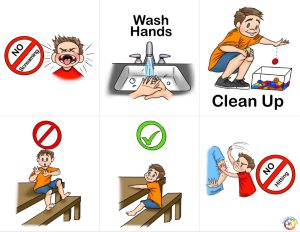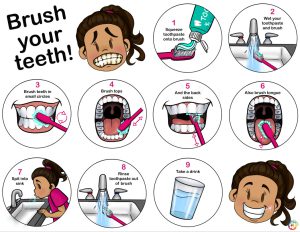See the Difference: How Visual Supports Can Assist Children with Special Needs
Understanding expectations, instructions, and routines can sometimes be a daunting task for children with special needs. However, studies repeatedly show that when information is presented visually, children are more likely to understand the expectation and gain independence, as they become less reliant on adult direction (Boddaert et al., 2003; Gervais et al, 2004; Rutherford et al, 2020; Steinbrenner et al, 2020; Wong et al, 2015). Moreover, visual supports can help to provide predictability and prevent worry that can arise from uncertainty.
Ready to weave visual supports into your home?
Remember, each tool has a unique role to play, and the key lies in selecting the ones that are best suited for your child and family. For example, visual schedules can help guide children through their day. Use them to outline the day’s activities, such as prepping for school or winding down for bed. Household rules also benefit from visual representation, providing clear expectations. Want to make chores more fun and less daunting? Create picture charts! This transforms tasks into understandable steps, making them less overwhelming.


Review the information included in the links below to get started! Visual supports can simplify daily routines and encourage independent behaviour in your child. You may also consider using pictures of your child doing the desired task and add them to the visual supports you create.
- Visual Supports – Care 4 the Caregivers (Customizable and downloadable visual supports for everyday tasks.)
- Do2learn: Educational Resources for Special Needs
References
Boddaert, N., Belin, P., Chabane, N., Poline, J.B. Barthélèmy, C., Mouren-Simeoni, M.C. Brunelle, F., Samson Y., & Zilbovicius, M. (2003). Perceptions of complex sounds: abnormal patterns of cortical activation in autism. American Journal of Psychiatry, 160, 2057-2060
Gervais, H., Belin, P., Boddaert, N., Leboyer, M., Coez, A., Sfaello, I., Barthelemy, C., Brunelle, F., Samson Y., & Zilbovicius, M. (2004). Abnormal cortical voice processing in autism. Nature Neuroscience, 7(8), 801-802.
Rutherford, M.; Baxter, J.; Grayson, Z.; Johnston, L.; O’Hare, A. Visual supports at home and in the community for individuals with autism spectrum disorders: A scoping review. Autism 2020, 24, 447–469.
Steinbrenner, J.R.; Hume, K.; Odom, S.L.; Morin, K.L.; Nowell, S.W.; Tomaszewski, B.; Brock, M.E.; Savage, M.N. Evidence-Based Practices for Children, Youth, and Young Adults with Autism; The University of North Carolina: Chapel Hill, NC, USA, 2020.
Wong, C.; Odom, S.L.; Hume, K.A.; Cox, A.W.; Fettig, A.; Kucharczyk, S.; Plavnick, J.B.; Fleury, V.P.; Schultz, T.R. Evidence-based practices for children, youth, and young adults with autism spectrum disorder: A comprehensive review. J. Autism Dev. Disord. 2015, 45, 1951–1966.


